Cooper FX Arcades review: Plumbing the depths of lo-fi guitar effects
The game console-like cartridge system is no mere gimmick.
Let’s get one thing out of the way right up front: Yes, the main conceit of the $329 Cooper FX Arcades is a little gimmicky. It’s a guitar pedal into which you stick cards to apply different effects, kinda like a game console. But while the somewhat novel approach to building a multi-effects unit may have helped Arcades garner attention, this pedal is no mere gimmick.
History
Coming soon! #chipswap #cartridge #cooperfx
A post shared by Tom Majeski (@cooper.fx) on Apr 29, 2017 at 3:25pm PDT
Tom Majeski of Cooper FX is not the first person to take this approach. Line 6 had its ToneCore line of pedals in the mid ‘aughts, Elta had the Console and TipTop Audio sells the Z-DSP. But Z-DSP is a eurorack module, not a guitar pedal. The discontinued Console was a fascinating device, but it’s odd joystick control seemed better suited to synth players. As for the Line6, the tech just didn’t seem mature enough at the time to deliver the tone players demanded.
The Arcades, on the other hand, is a pretty straightforward pedal, with lots of thoughtful interface choices. It’s also built around one of the most flexible digital signal processors (DSPs) out there: the FV-1. Now, I could easily spend 3,000 words talking about the wonders of the FV-1. (Don’t worry, I won’t.) It can be found in pedals from the likes of Chase Bliss, Walrus Audio, Red Panda, EHX and countless other manufacturers, big and small. For something originally introduced in 2006 it’s proven surprisingly resilient and malleable.
It’s the shapeshifting power of the FV-1 that drove Majeski to dabble with the concept of a card-based multi-effects pedal years ago. But it wasn’t until 2020 that it would finally see the light of day (after some pandemic-related delays). When it launched in late April there were four cards each with eight effects. That number has since doubled, bringing the total number of available effects on the Arcades to 64. And Majeski is actively taking suggestions from the community about effects he should add next. We’ll dive into some of the specifics a bit later, but suffice to say there’s already a lot of effects to play with and the promise of more on the way.
In use
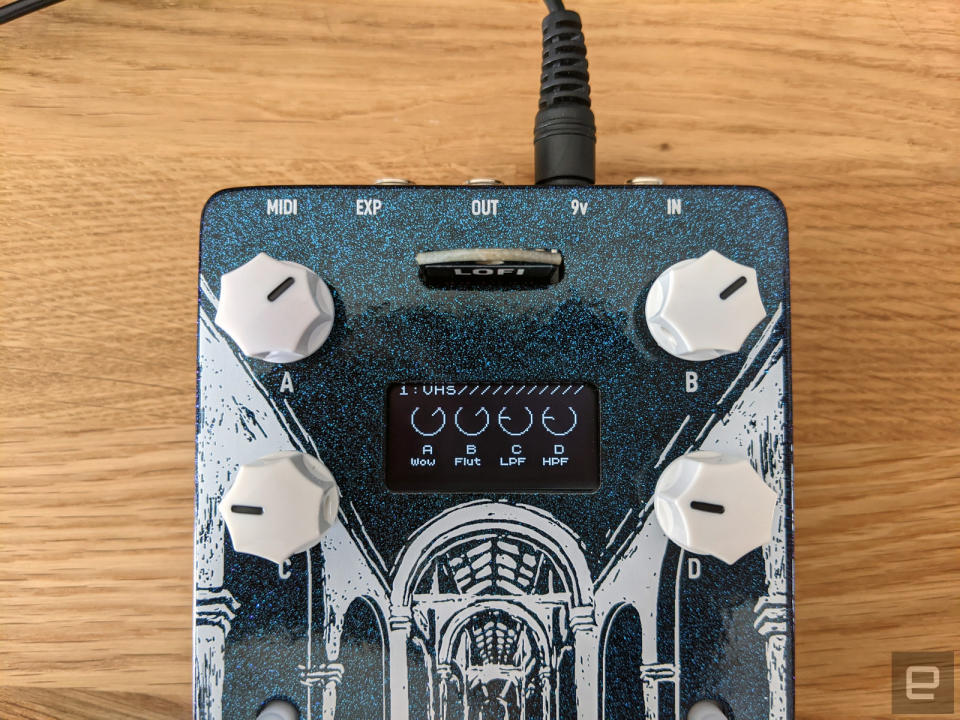
But I want to start with one of the things that the Arcades gets so impressively right: the interface. Considering the breadth of effects it covers and the number of options, it would have been easy for the pedal to become an unwieldy mess. But on the front are just two foot switches, two buttons, four knobs and a small screen. (Just to round out the hardware, around back you’ll also find MIDI in and an expression pedal jack.)
The display is bright enough to be seen even in direct sunlight. While that probably won’t be a scenario you encounter often, I feel confident saying the glare of stage lights shouldn’t be too much of an issue. It’s small and recessed enough that your foot won’t pose a danger to it. Plus, it’s sandwiched directly in the middle of the four knobs, so you’d really have to go out of your way to stomp on it.
Note about the demos
All of the demos in this review are played on a Fender Toronado and recorded direct into Ableton and Guitar Rig 5 using the Jump amp (Marshall JMP). Any additional drive or distortion is provided by smallsound/bigsound’s Fuck Overdrive. No other effects are used except in the Grain demo which also includes reverb from Walrus Audio’s Slö.
Since this is a multi-effects pedal, the knobs have to perform multiple functions. They’re labeled A, B, C and D, and the screen tells you what they’re actually controlling at a given time, whether that’s the decay of a reverb or the dry mix of a synth effect. The two small buttons on the front allow you to navigate the screen. They perform multiple duties as well, but they’re easy to master. On the left is the PRGM button, which cycles through the eight effects on each card when you tap it. Long pressing brings up a system menu, where you can save and load presets, change the MIDI channel or control the quantization of the DSP clock. (More on that later.)
The Page button on the right swaps between two sets of controls for the knobs. One is global settings like wet and dry volume levels, tone and clock speed (again, we’ll dig into this later); the other set is specific to each effect. Long pressing the Page button unlocks one of the Arcades’ greatest powers: the assignment menu. This is where you can assign parameter changes to the AUX footswitch or an expression pedal.
The AUX/Tap footswitch on the left can be either a tap tempo (very useful for delays) or an auxiliary control that allows you to immediately jump to a second set of settings. You can use it to crank the delay feedback to the max for wild self-oscillating freakouts. Or switch between octaves and fifths on a pitch shifting program. Or freeze a reverb to create a pad for you to solo over.
Engadget · Cooper FX Arcades - LoFi
You can also assign multiple parameters to the footswitch or to an expression pedal, too. So, if you want to smoothly turn down the sample rate and while simultaneously increasing the flutter on the lo-fi Delay, you can do that. You can even set the range of the expression pedal so if you want a full sweep to only make subtle changes, it can do that.
And look, there’s plenty of pedals out there with assignable footswitches and expression ports. But the simplicity of assigning things here and the breadth of options is impressive. All you have to do is turn the knob corresponding to the parameter you want to what the secondary setting should be and voila!
Without a screen, pedals usually rely on obscure button combinations for assigning parameters. You’re often only able to assign one at a time, and there’s no way to quickly see what’s assigned. Even many pedals with displays don’t feel this intuitive or direct.
The same goes for the process for saving and loading presets. When you open the system menu by long pressing the PRGM button, the A knob scrolls through the presets. (There are eight in total.) You then press and hold the bypass footswitch to save a preset or press and hold the aux footswitch to load one. That’s it. Everything is pretty simple.
The cards
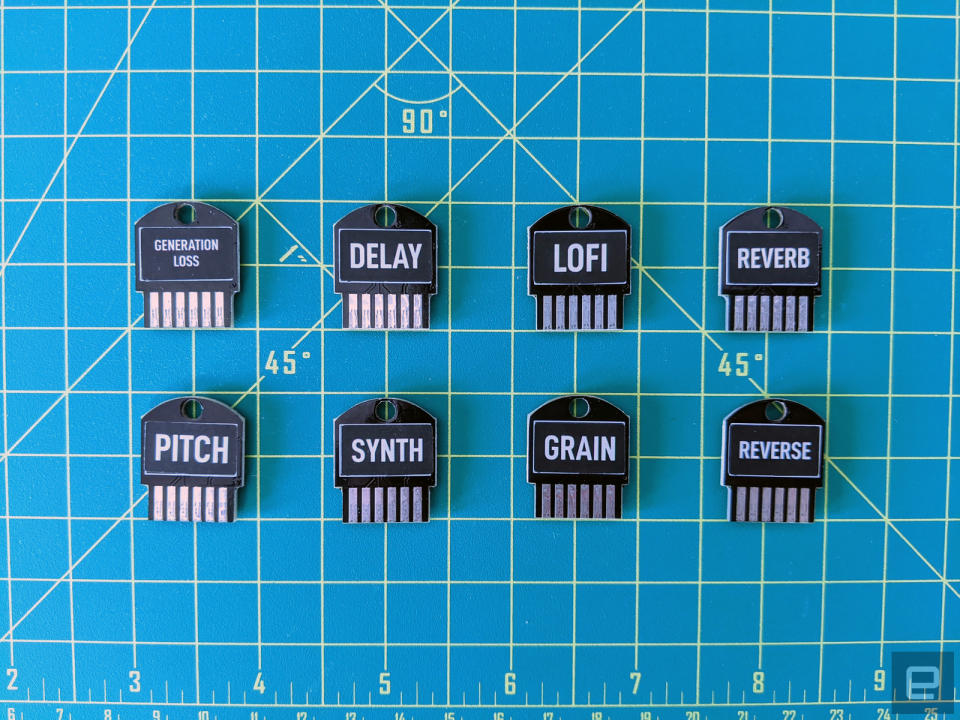
All of this is at least in part due to a decision made in how to handle the cartridges. See, the Console and Z-DSP use simple EEPROM cards with program data that’s fed to the FV-1 inside. The Arcades actually uses a microcontroller to emulate an EEPROM. It’s also what tells the screen what to display, allows for the saving and loading of presets and does some other housekeeping work. So, while the cards might seem a little pricey at $49 apiece, know that you’re not just paying for a glorified SD card. (You also get two of your choosing with the pedal.)
Cooper FX doesn’t claim the cards are hot-swappable, but I’d say a good 75 percent of the time I could get a newly inserted card to load without having to power the pedal on and off.
Each of the eight currently available cards are loosely themed around a particular kind of effect: Delay, Reverb, LoFi, Pitch, Synth, Grain (granular), Reverse and Generation Loss (after the beloved pedal of the same name built by Cooper FX). There is a decent amount of overlap between the cards. Not that the same exact effects are replicated, but they have a very similar vibe. And most of the effects lean into the lo-fi character that Cooper is best known for. There are crisp clean digital delays here and endless unnatural reverbs that seem like something straight out of a sci-fi movie. But a good chunk of the effects do things like try to emulate VHS warbles and aging vinyl or do glitchy granular processing.
Engadget · Cooper FX Arcades - Reverb
There’s a VHS algorithm on the Reverb, Delay and Generation Loss cards. And, in addition to a dedicated LoFi card, there are LoFi programs on the Synth, Reverse and Grain cards. Majeski knows his audience and is catering to it. They deliver things like random vibrato and bit rate reduction to capture the feel of aging tapes, old samplers and skipping CDs. These sorts of effects are very in vogue right now, and Cooper FX has proven itself quite adept at them.
To see that expertise, you need only look at the Generation Loss card. This is a selection of effects built around the original Generation Loss pedal, which can fetch over $500 on Reverb. Generation Loss is billed as a VHS simulator -- it adds wow, flutter and noise to your guitar signal and basically just makes everything feel warm and nostalgic. Now, the original Generation Loss has two FV-1 chips inside. Yet, Majeski managed to cram most of the features into this single chip pedal mostly by making a few interface tweaks.
The most obvious sacrifice is going from six controls to four on the Arcades. To compensate the various programs on the Generation Loss card focus on specific combinations of its parameters and explore relationships between them. Think of it kind of like a guided tour through the Generation Loss’ greatest hits.
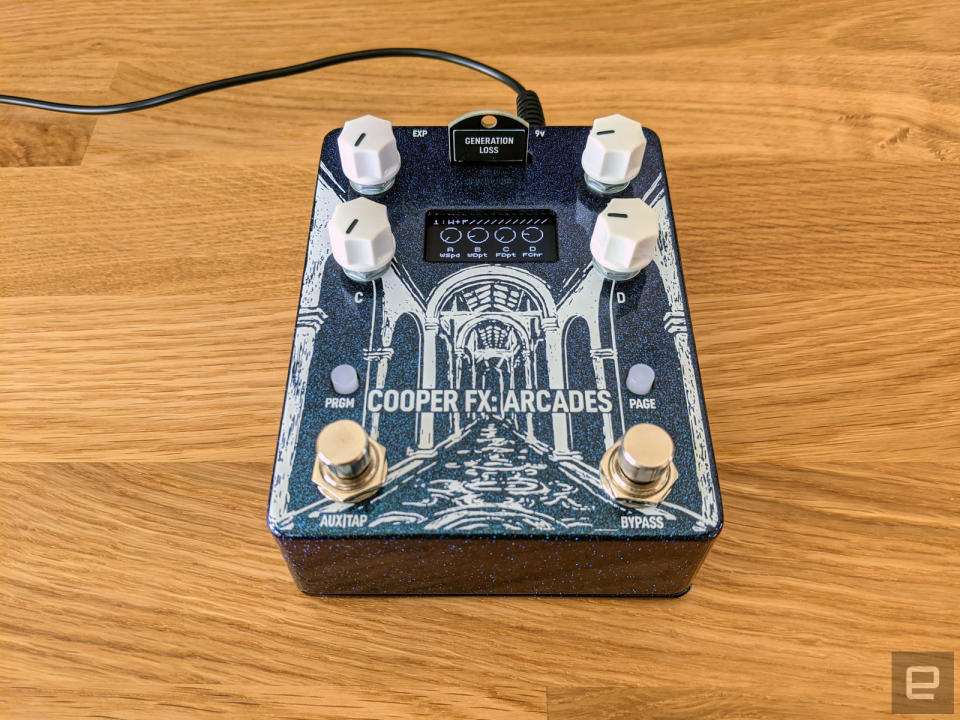
It’s probably my favorite of the cards. All eight of the programs are not just usable but excellent. The Vintage and VHS Delay in particular are amazing and worth the price of entry alone. Then there’s CD skip which, while difficult to tame, is just super fun to let rip stuttering glitchy solos with. Look, I’m never going to be able to justify a $500 guitar pedal to myself, so a real Generation Loss is out of the question. But, $329 isn’t out of the realm of possibility. It’s on the higher end of what a typical boutique pedal costs, but it’s in no way absurd.
The LoFi card is similarly packed to the brim with just impressively crafted sounds. The VHS program is very similar to the ComboA option on the Generation Loss card. But it still stands on its own. There’s a lo-fi delay and a pair of reverb options on here. The BITVRB is a particular favorite of mine. It’s a crushed, kinda harsh digital effect that can sound like you’re playing through some busted 80s rack gear.
This is where that clock control can really shine. What it does is actually set the operating frequency of the DSP, so as you turn it down your signal is crushed more and more into digital oblivion. At around 12kHz you get a lovely old-school sampler vibe. At 8kHz you start getting SNES guitar sounds. And by the time you get to 2kHz it’s just sputtering noise.
Engadget · Cooper FX Arcades - Delay
Changing the clock speed also changes the timing of the effects -- this is important to keep in mind especially with delays. Higher frequencies mean higher quality audio, but shorter delay times, while lower frequencies can extend delay times at the expense of audio fidelity. But this can also impact the timing of delays because the resolution is always 512 values. So at 60khz you will have approx 500ms of delay and sub-millisecond accuracy. But, at 2kHz, you will have approximately 16 seconds of delay and a possible margin of error of 31ms.
Before we move on to some of the other cards, I also feel it necessary to mention the CRUSHR program on the LoFi card. It is phenomenal. It has a filtered synth, almost bit-crushed sound that is equally at home doing spacey ambient pads as it is sitting in for an octave fuzz on a stoner rock riff.
Engadget · Cooper FX Arcades - Pitch
So yes, two of my favorite cards are all about that lo-fi life. But that’s not all there is here (it’s just the quickest way to my heart). The reverb and delay cards are also incredible from top to bottom. The Delay card might be the most traditional of the effects packages offered, but it’s also extremely versatile. There’s a crisp, clean and classic digital delay, with the option to add chorus or vibrato; an emulation of old bucket brigade analog delays with dark and noisy repeats; a tape delay emulation with wow and flutter added to the echoes; a granular delay which samples a note and chops it up into little bits before spitting it back out for synthy and glitchy tones, and so much more.
The Reverb card gets a little more exotic. In fact, its shimmer mode might be the most “traditional” reverb here. The MULTI program is made up of many tiny delay taps squished together. At more conservative settings it’s fairly standard sounding, but as you crank things up it quickly becomes an otherworldly echo that seems to ring out from an endless abyss. There’s also an amazing VHS reverb with lots of wow and flutter, but the most bizarre is probably ARP which arpeggiates (I promise it’s a word) your reverb tails off into infinity.
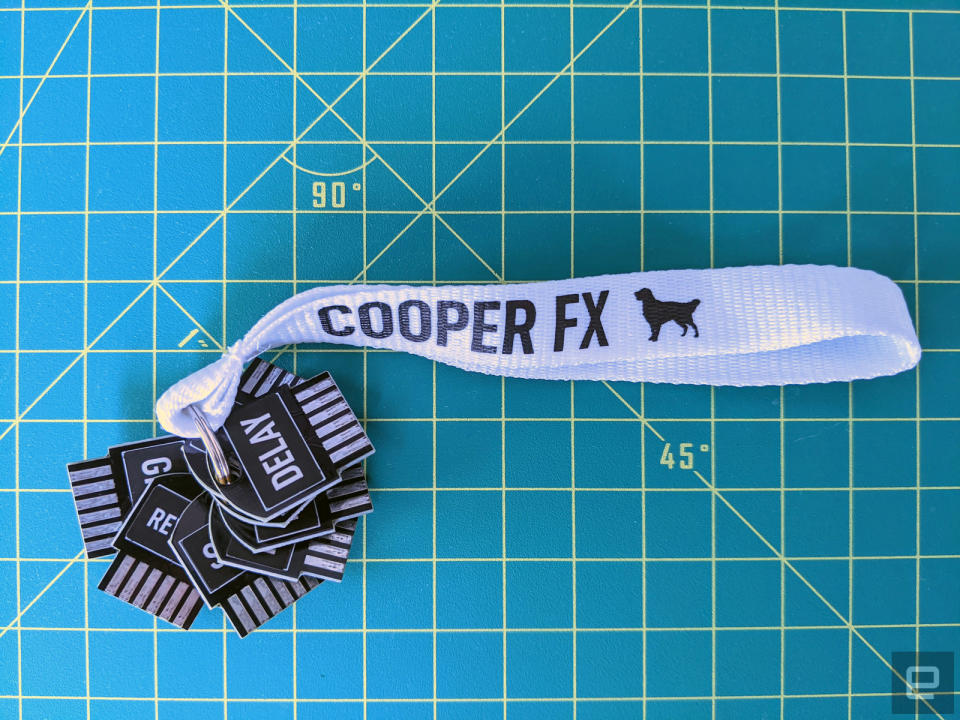
The other cards all have plenty of usable sounds and highlights as well (organ on the Pitch card for instance), but if I had to pick I’d say the Generation Loss, LoFi, Delay and Reverb were the best of the bunch.
Honestly, the only card that I didn’t immediately find an effect to click with on is Grain. I was quite excited to start doing some serious granular damage to my guitar riffs, but I’ve found it quite a challenge to make the effects here work for me, at least on their own. When fed through additional epic reverbs and delays, though, they can really shine. Just know that where the other cards deliver effects that easily stand on their own, the Grain card seems to need a little help from some friends.
Beyond guitars
Engadget · Cooper FX Arcades demo
I’ll also admit that I simply haven’t explored the MIDI capabilities of the pedal at all. MIDI just isn’t something I’ve incorporated into my pedalboard at this point. Though, it’s easy to see how, when paired with something like the ZOIA, external LFOs and envelopes could add even more life and movement to a collection of effects already brimming with personality.
It’s also worth noting that most of the effects here play just as well with synths as they do guitars. With the exception of a few envelope controlled glitchy options. And, of course, if you’re playing an actual synth, there’s no real need to use a synth effect. But, hey, whatever makes you happy.
Wrap-up
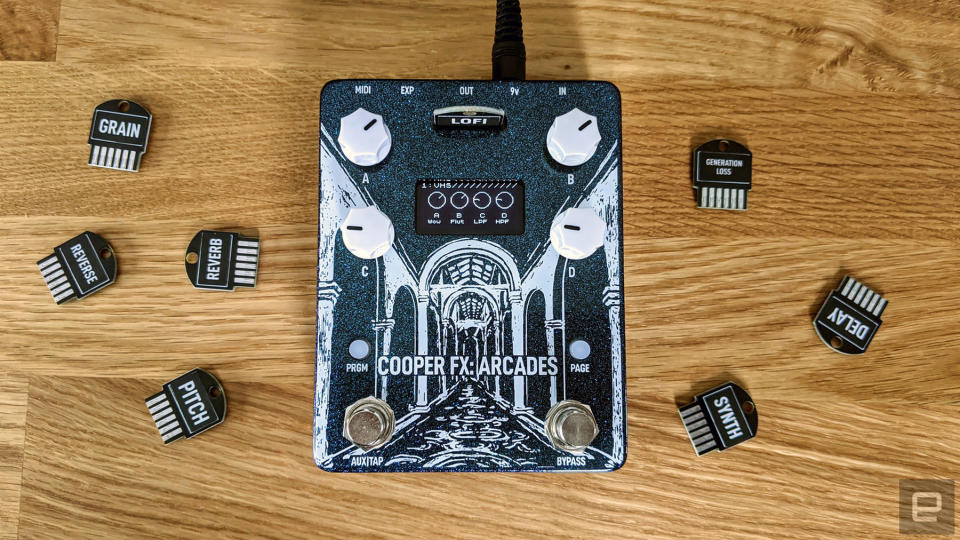
The beauty of the Arcades isn’t really in how many effects it has, though, it’s about how deeply it explores all the various combinations of its key characteristics. It plumbs the depths of lo-fi like no other pedal out there. If you just want something that will put a pedalboard’s worth of effects at your feet, that’s what a Zoom pedal is for. What you get here is a device that repeatedly asks “what if you combined A with B?” or “what happens when you push this to its logical extreme?” And while there are countless lust-worthy lo-fi pedals out there, few offer as broad a scope and as clear a value as the Arcades.

